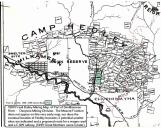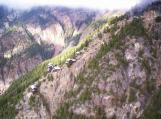1
The Golden History of Hedley and the Nickel Plate and Mascot MinesIn 1902 the Yale Mining Company (reformed in 1904 as the Daly Reduction Company) selected the Twenty Mile Creek basin for development of the mining infrastructure and townsite. The Similkameen Valley Gold Rush was on and hundreds rushed to Camp Hedley for work and with hopes of gold.
One of the first projects to get under way was the need for a steady water supply; preliminary surveys of Twenty Mile creek for a water flume and tramline began. Clearing the right of way, bringing in milled timber that was hauled in by horse teams, and then carrying to where it was built into trestles for the flume took a lot of brawn and inventiveness.
Finally, in 1904, six years after Wollaston and Arundel's lucky discovery, the mill and its infrastructure now in place, the Daly Reduction Company began full operation and the muffled roar of the machinery became a familiar sound in Hedley 24 hours a day for most of the next 50 years.
By 1907 Camp Hedley had become the most important mining operation in the Similkameen district with the Nickel Plate mine one of the largest producers in Canada. At the work site good ore continued to be located and approximately 42,000 tons per year were going to the mill.
At the mill, gold was being recovered three ways:
First there was the free gold that was taken directly off the bars of the large stamps that were used to crush the ore.
In addition, gold was recovered from a cyanide bath process; each month a gold brick was produced from these two processes and shipped under special escort to Penticton B.C.
Finally, the heavy concentrate from another part of the operation, after some initial drying, was being shipped in 100 pound sacks to the smelter in Tacoma, Washington for further refining.
Eventually the upward mining activity broke through to the surface. Additional work produced a huge glory hole (open pit). Once the ore around this glory hole was exhausted another adit was driven, in 1908, at the 5600 foot level. This adit encountered very little ore. Thinking that the ore was exhausted, the Daly Reduction Company sold the operation to the Hedley Gold Mining Company in 1909.
The new company located ore that the previous group had missed, and for the next quarter of a century the mine did extremely well. Production was increased to over 75,000 tons per year, recovery procedures at the mill were improved, and dividends in 1912 reached 30%.
With increased production came the need for more power. In 1911, in order to provide additional water for the steam plant, the only source of power generation, a 7000 foot long ditch was constructed to convey the water from the melting snow on local mountains to Strayhorse (Nickel Plate) Lake which empties into Twenty Mile Creek. More power was needed and in 1915 a 2000 horsepower dam was completed on the Similkameen River just below the outlet of Twenty Mile Creek.
Unfortunately, this power plant would sometimes be forced to shut down because of ice on the river. In 1920 and again in 1925 the entire mill had to be closed for the winter due to shortage of water and the resulting lack of power.
For the first time since the mine started the future looked bleak when in 1929 new ore could not be located. Over 20 miles of diamond drilling had had been done, but nothing looked promising. For the 75 men underground and the 25 on the surface the end seemed near. To make matters worse the company had not been able to purchase the tiny Mascot fraction from Duncan Woods, the stubborn owner of the Mascot Fraction. After 27 years of operation, the Hedley Gold Mining Company shut down and offered to sell the entire operation for only $65,000.
Hedley Mascot Gold Mine Ltd, the Beginning
When the aged hardliner Duncan Woods decided to sell his Mascot Fraction, the small wedge shaped claim sandwiched between the Nickel Plate properties, he received a the sum of $150,000. This was a huge amount of money in the 1930's, but Woods didn't live long to enjoy it, he died in 1933.
The new owners, Hedley Mascot Gold Mines Ltd, took over 31 other crown-granted claims adjacent to the fraction in order to have enough room for their tram lines and mill. The property was rich and like the Nickel Plate, also required some novel methods for ore removal. Since the claim was on a cliff face 300 feet above the valley, access was extremely difficult. Ground transportation was out of the question. The solution was an aerial tramway constructed from the mine portal to a mill location on Twenty Mile Creek just upstream of Hedley.
Another early achievement was the cluster of buildings that were constructed on the precipitous crags that surrounded the new tunnel. These structures housed several of the workers and provided most of the mechanical facilities that were needed of the mine. There was even a cookhouse and accommodation.
Fortunately, the new Mascot management had a much more cooperative attitude than Woods. One of the first demonstrations of this good will was the permission for a connection from the lower workings of the Nickel Plate mine to the main level of the Mascot in order to give better ventilation to both operations. This connection also allowed the seepage of the water from several sections of the Nickel Plate to drain out through the Mascot. Eventually both the Mascot and the Nickel Plate mines were working in the same ore body.
By 1947 and after exhausting the ore deposits, the ore grade in the mine dropped from approximately .50 oz. of gold per ton to .39 oz per ton. At this rate the Mascot could not afford to continue working on a new incline. Additional richer ore had not been located. The following year in 1948, there was a cave-in on the Nickel Plate mine side or the ore body in the loose ground of the morning workings. This caused some movement in the adjacent Mascot stopes, but since it occurred when the crews were off shift no one was hurt.
By 1949 the known economic pockets had been cleaned out. The remaining ones were either too expensive to reach or too low in values. After 13 years of operating under difficult conditions the Mascot closed. All the useful equipment was removed. The buildings were abandoned. During its brief history the little Mascot Fraction produced over 682,000 tons of ore. The resulting 8 tons of gold were worth $8,000,000. The shareholders had also been rewarded; the company had paid $1,250,000 in dividends.
The closing of the Nickel Plate Mine
After nearly fifty years of production, the Nickel Plate mine was running out of ore. Extensive diamond drilling over the precious few years had been in vain. A few ore pockets were located, but these were either too small or too far away to be economically mined. Reluctantly, the men of Nickel Plate mine worked their last shift on September 23, 1955.
The total ore removed from the Nickel Plate mine was 3, 289,000 tons. By today's open pit mining standards this is not a great amount. Early day miners, however, did not have the benefit of huge front end loaders and gigantic dump trucks. Every ton was either shovelled by hand or, if the workings were large enough, scraped by air driven scrapers. In many situations the ore would be scraped and shovelled several times before it finally reached an ore car.
The average grade of ore was .34 oz. per ton. A staggering 46 tons of gold were produced. The gold value at the time of the mine's closing was worth $37,000,000. Finally, the optimists, the backers of this mountain top venture, actually saw dividends. A total of $5,283,744 was paid out over the years to those who had gambled on finding gold at Nickel Plate and won.
In 1995 the Mascot Mine site was officially designated a Provincial Heritage resource and after an extensive restoration process was completed, visitors now can witness for themselves the inventiveness and the tenacity of those early-day miners.
2
Mining Map of Camp Hedley, Nickel Plate Mountain and Area ca. 1900Early 20th Century, 1900
Similkameen Valley, B.C. Canada
 Credits:
Credits:Hedley Heritage Museum Society
3
Panorama View of Hedley Townsite, in the Similkameen Valley ca.194020th Century, Circa 1940
Hedley, British Columbia
 Credits:
Credits:Hedley Heritage Museum Society
4
Stamp Mill: Cross Section Plan of the Daly Reduction Company ca. 190520th Century, Circa 1905
Stamp Mill, Daly Reduction Company, Hedley B.C., Canada
 Credits:
Credits:Hedley Heritage Museum Society
5
The Daly Reduction Company - Management - July 14, 19071907
Stamp Mill, Daly Reduction Company, Hedley B.C., Canada
 Credits:
Credits:Hedley Heritage Museum Society
6
Daly Reduction Stamp Mill, Construction Workers ca.190320th Century, Circa 1903
Stamp Mill, Daly Reduction Company, Hedley B.C., Canada
 Credits:
Credits:Hedley Heritage Museum Society
7
Ore Train for Nickel Plate Mine Postcard ca. 1905Early 20th Century, Circa 1905
Stamp Mill, Daly Reduction Company, Hedley B.C., Canada
 Credits:
Credits:Hedley Heritage Museum Society
8
Gold Brick at the Hedley Gold Mine Co. May 1, 191820th Century, Circa 1918
Hedley Gold Mine Company, Hedley, B.C. Canada
 Credits:
Credits:Hedley Heritage Museum Society
9
Similkameen River, Hydro-Electric Dam Completed ca. 191520th Century, Circa 1915
Hydro-Electric Dam, Similkameen River, Hedley, British Columbia, Canada
 Credits:
Credits:Hedley Heritage Museum Society
10
Hedley Mascot Gold Mining Co 194120th Century, Circa 1941
Mascot Mine, Nickel Plate Mountain, British Columbia, Canada
 Credits:
Credits:Hedley Heritage Museum Society
11
Nickel Plate Ore Bin & Train on Tramway ca.193520th Century, Circa 1935
 Credits:
Credits:Hedley Heritage Museum Society
12
Miner-John Miller, Nickel Plate Mine ca.193620th Century, Circa 1936
Mascot Mine, Nickel Plate Mountain, British Columbia, Canada
 Credits:
Credits:Hedley Heritage Museum Society
13
Glory Hole Stope Nickel Plate Mine ca.195120th Century, Circa 1951
Mascot Mine, Nickel Plate Mountain, British Columbia, Canada
 Credits:
Credits:Hedley Heritage Museum Society
14
Paragliding Above Mascot Mine Fraction ca. 200921st Century, Circa 2009
Mascot Mine, Nickel Plate Mountain, British Columbia, Canada
 Credits:
Credits:Hedley Heritage Museum Society
R Moncrieff